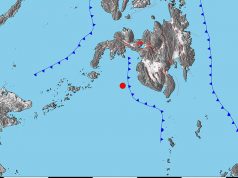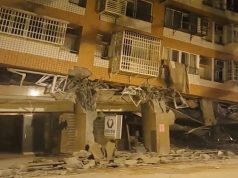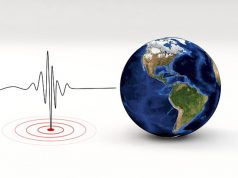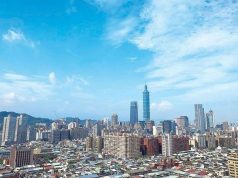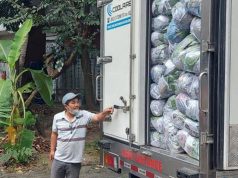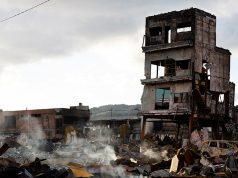
From end to end.
Broadcast journalist Noli “Kabayan” de Castro was interviewing the president of the Philippine Medical Association in Ilocos Sur when she got cut off due to the earthquake.
It wouldn’t be long before De Castro would feel the tremor too.
DZMM Teleradyo shared a video of the moment on social media, where it said that the tremors were felt in ABS-CBN’s broadcasting studio shortly after the interviewee felt it.
“Naramdaman ang paglindol sa studio ng TeleRadyo habang isinasagawa ang interview sa pangulo ng Philippine Medical Association, pasado alas-8:45 Miyerkoles ng umaga,” the radio station said.
De Castro was interviewing physician Maria Minerva Calimag about the Vape bill through a video call when her screen started to shake.
“Uy, lumilindol po ah!” she exclaimed.
The broadcaster asked her location and she responded she is in Ilocos Sur, which is around 361 kilometers away.
A few moments after, Calimag’s screen froze.
De Castro explained to his listeners that the doctor’s signal got cut off and then told the staff in the studio to “follow up” reports of the earthquake in the area.
At around 8:44 a.m., the camera broadcasting “Kabayan” started to shake but the journalist did not notice this until a minute later when the tremors got stronger.
“Uy, teka muna! Lumilindol din dito!” he exclaimed.
De Castro added that he thought he was just feeling dizzy.
“Kung Ilocos Sur, at abot dito, malakas!” he told his staff.
“Sabi niya lumilindol doon sa Ilocos Sur, o tapos sumunod tayo. O, ibig sabihin, mula Ilocos Sur hanggang dito? Malakas ‘yon. Malakas ‘yon. Ang tagal pa ha,” De Castro added.
The video fascinated and scared Filipinos at the same time.
“Utterly fascinating video that shows how earthquakes travel. The anchor was interviewing someone 400 km away from Metro Manila when she reported feeling the quake before her feed was cut. About a minute later, the anchor in Metro Manila then feels the quake himself,” lawyer Oliver Reyes said.
“Believe me, palakas pa lang ‘yung earthquake sa Ilocos Sur bago na-cut ‘yung feed. It was way stronger and then panic ensued due to the Tsunami warning minutes later. It was chaotic, like a scene in a movie,” another Twitter user said.
“WILD, they caught the earthquake travel from Ilocos to Metro Manila,” wrote a different user.
“Oh wow, Dr. Camalig in Ilocos Sur being interviewed and then took less than a minute para maramdaman na rin sa QC ang lindol. Ganun kabilis nag-travel ‘yung waves,” another Twitter user noted.
“Pinanonood pa namin ‘to eh tapos… nauga na ‘yung upuan ko,” commented a different Pinoy.
The Philippine Institute of Volcanology and Seismology on Wednesday recorded a 7.0 magnitude tectonic earthquake on Tayum, Abra at 8:34 a.m.
Several infrastructures were damaged from the incident, including heritage sites in Vigan and antique bell towers in the Ilocos provinces.
READ: Aftermath of July 27 Abra quake: Damaged buildings, heritage sites
Apart from Northern Luzon, some cities in Metro Manila also felt the tremor.
Phivolcs said that Malabon and the city of Manila had felt the quake at Intensity V.
This is considered strong which means that it was “generally felt by most people indoors and outdoors” and there was “strong shaking and rocking felt throughout building.”
Quezon City, where ABS-CBN’s studio is located, felt the quake at Intensity IV.
This is described as “moderately strong” which is generally felt by those indoors and some people outdoors.
“Vibration is felt like a passing of heavy truck” and “hanging objects swing considerably,” according to Phivolcs.
Some parts of Ilocos Sur, where Calimag was, had a reported Intensity VI. This is described as “very strong” in which “many people are frightened.”
“Some people lose their balance, motorists feel like driving in flat tires. Heavy objects or furniture move or may be shifted,” Phivolcs said.
Other towns in Ilocos Sur also felt the tremor at Intensity V.
A note on seismic waves
Seismic waves, also known as “shock waves” or the energy released by earthquakes, are known to travel as fast as up to two miles per second in granite.
There are different types of these waves and each is able to travel at different rates of speed.
The fastest seismic waves are the “P” waves or the primary waves. These are the first to arrive at seismometers from some distant earthquake.
The “P” waves travel between five and eight kilometers per second at the earth’s surface.
Deeper within the planet, they can travel up to 13 kilometers per second.
“P” waves travel through rock the same way that sound waves do through air.




